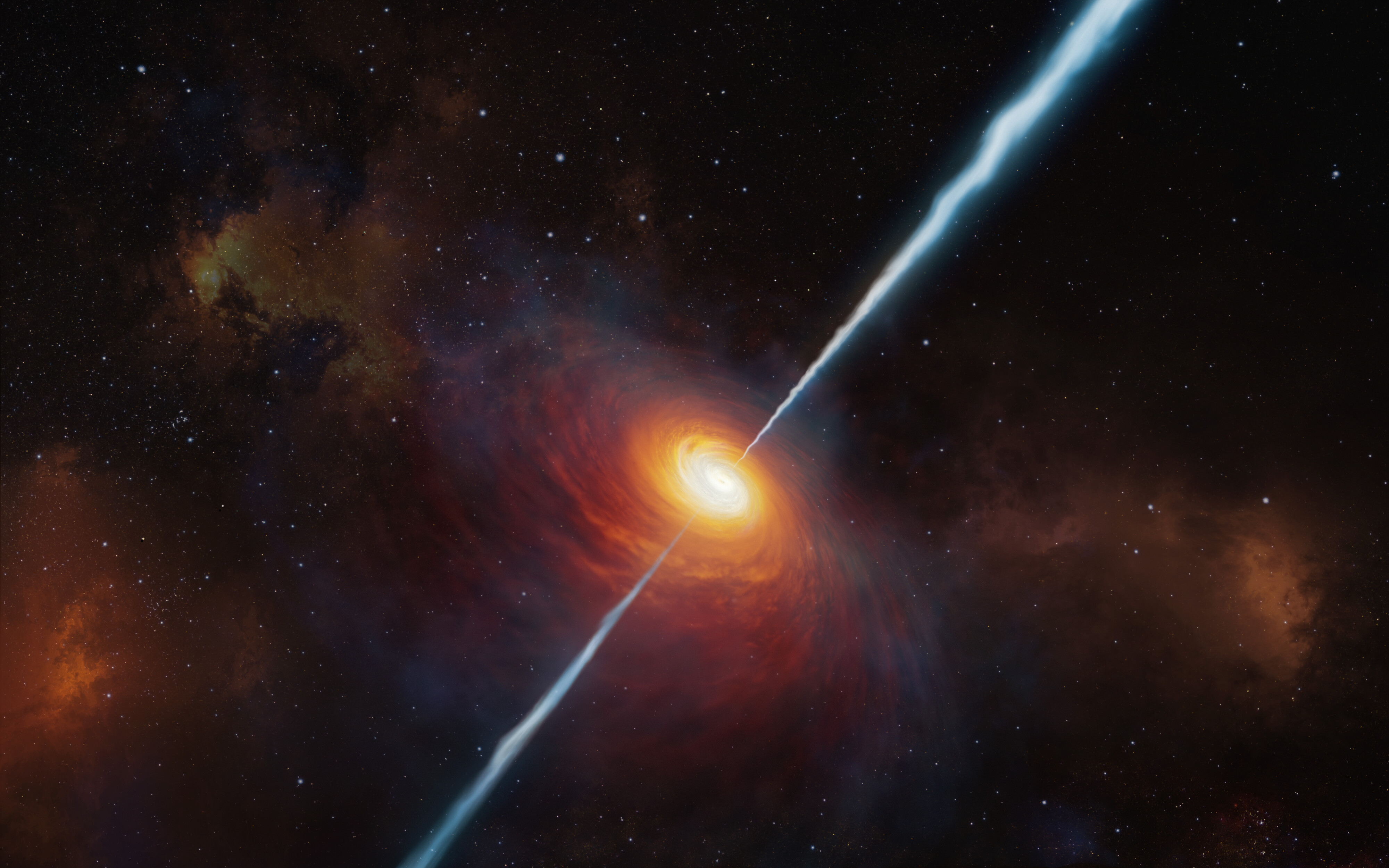Distant jets are giving us clues to how supermassive black holes get so big
The new findings include the most ancient radio-wave-spewing black holes ever seen by astronomers.

At the center of every galaxy is a supermassive black hole—a monster that keeps the neighborhood of stars and planets and gas and dust together. Over the decades since astronomers began studying them in earnest, we have confirmed that these objects indeed exist; we’ve learned they are likely essential for helping stars form; and we’ve even developed a technique for imaging them directly. However, one big question has left astronomers stumped: How do these beasts grow so massive, so quickly?
They key may lie with astrophysical jets—bursts of energized particles and radiation that supermassive black holes occasionally belch out. We don’t know exactly why they do this, but two new record-breaking studies from the same international team of astronomers suggest that whatever the cause, these jets might help supermassive black holes grow.
The first finding, reported in the Astrophysical Journal, is the discovery of a supermassive black hole 13 billion light-years away that’s 300 times more massive than the sun. The astronomers used infrared observations from the Magellan telescope at Las Campanas Observatory in Chile to confirm it’s the source of a jet first detected in 2015. This supermassive black hole is now the most distant (that is, the oldest) jet-producing black hole ever detected.
The second, in a preprint study that will soon be published in the Astrophysical Journal, is the discovery of an astrophysical jet from a supermassive black hole 12.7 billion light-years away and over a billion times more massive than the sun, first discovered in 2018. The team used NASA’s Chandra X-ray Observatory, which looks for x-ray emissions from very hot objects in the universe, to make these observations. It is the most distant astrophysical jet ever to be observed in x-rays.
Each set of findings breaks some esoteric astronomy records, but that’s not why they’re a big deal. Both help explain why supermassive black holes are able to grow so quickly even though they’re constantly releasing high-energy matter. What the team found is the first evidence of its kind that the jets actually encourage a black hole’s rapid feeding.
In the first investigation, after Magellan confirmed the black hole’s existence, the team used other instruments, like the Very Large Telescope in Chile, to discern other properties about the black hole and its jet, such as mass.
The additional data demonstrates how the jets encourage feeding. The intense gravitational force of the black hole is trying to pull massive amounts of gas and dust into its event horizon (the point of no return). This matter has angular momentum, meaning it doesn’t just fall straight in—it orbits the event horizon. Meanwhile, radiation pressure in the area (created by friction and stress in the disk of orbiting matter heating itself up until it is glowing) continues to push the gas away from the event horizon.
What happens is a bit complex, but essentially the jet’s beam of highly energized particles takes away angular momentum from gas as it moves outward. And unlike the radiation pressure, which shines and pushes out in all directions, the jet is narrow, and so it’s barely able to interact with and affect the less dense layers of gas farther out. With a way for gas to lose angular momentum with little pushback, much of the gas surrounding the event horizon simply falls right in.
“In this way, the jet ensures that the black hole isn’t working actively against itself—it’s able to continue feeding,” says Thomas Connor, a NASA astronomer and a coauthor of both papers. Although scientists have suspected jets might play a role in encouraging the feeding process, “until now we haven’t really seen compelling evidence for it,” he says.
The x-ray study bolsters this idea. Those observations revealed that the jet has traveled 150,000 light-years away from its source—making it the first x-ray observation of jets longer than just a few thousand light-years. “This large-scale x-ray detection means we’ve had these jets going on for incredibly long periods of time,” says Connor. They aren’t simply transient blips but were sustained for hundreds of thousands of years—enough time to actually help a supermassive black hole feed and grow very quickly. “We know now this is a long-term process, and that’s how these jets are actually able to help these supermassive black holes build up,” he says. “This the missing piece that connects 15 years of theory to where we are now.”
Both studies help lay the groundwork for follow-up findings that could help us learn more about how supermassive black holes evolved and helped shape the early universe. We now have a better idea of how to look for black holes from such ancient times, as well as an understanding that more x-ray observations could be critical to learning how the jet-feeding dynamic works.
For Connor, those additional observations will be the key. And he’s quite encouraged after this week’s one-two punch. The discovery “hopefully points to there being many more of these objects out there,” he says, “and I hope that we can break the distance record again soon enough.”
Deep Dive
Space
The search for extraterrestrial life is targeting Jupiter’s icy moon Europa
NASA’s Europa Clipper mission will travel to one of Jupiter's largest moons to look for evidence of conditions that could support life.
How to safely watch and photograph the total solar eclipse
The solar eclipse this Monday, April 8, will be visible to millions. Here’s how to make the most of your experience.
How scientists are using quantum squeezing to push the limits of their sensors
Fuzziness may rule the quantum realm, but it can be manipulated to our advantage.
Stay connected
Get the latest updates from
MIT Technology Review
Discover special offers, top stories, upcoming events, and more.